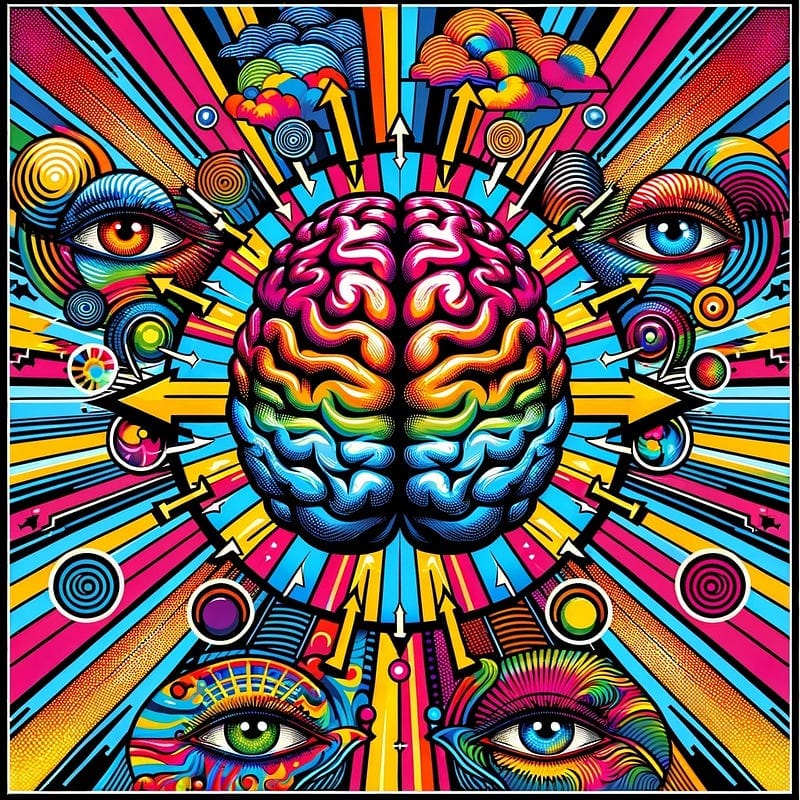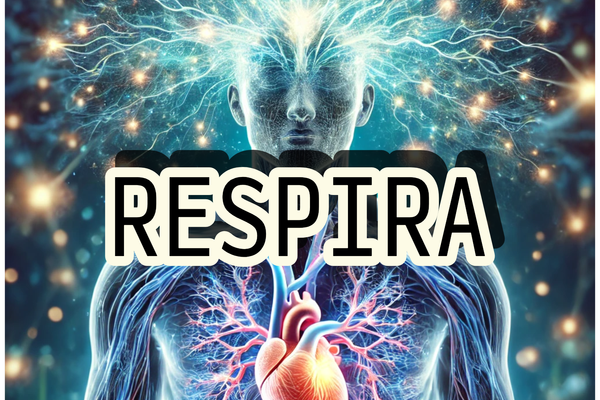Gazing into the Mind: How Eye Movements Influence Brain Activation and Altered States

In the ancient practice of Trataka, yogis would fix their gaze on a single point, often a candle flame, to still the mind and deepen their meditative state. This seemingly simple act of focusing one’s eyes is believed to unlock profound levels of mental clarity and inner peace. The renowned Zen master, Thich Nhat Hanh, once said, “The eyes are the windows to the soul.” This statement captures the essence of how our gaze can influence not only our perception but also our state of consciousness.
Our eyes do more than just see; they are intimately connected to the workings of our brain and mind. This article explores the fascinating relationship between eye movements, particularly the upward gaze, and brain activation, delving into how these movements can alter our states of consciousness. By understanding this connection, we can gain insights into practices ranging from everyday cognitive tasks to profound spiritual experiences.
We will begin by examining the basics of eye movements, focusing on how different directions of gaze are traditionally interpreted in cognitive processes. Following this, we will delve into the neurological basis of eye movements and how they relate to brain activation, particularly in the frontal cortex. The article will then explore the role of eye movements in everyday cognitive processes such as visual thinking, memory recall, and emotional introspection.
Next, we will investigate how eye movements are utilized in altered states of consciousness, including meditation, hypnosis, and REM sleep, highlighting the unique patterns observed in each state. The influence of psychedelics on eye movements and the resulting changes in sensory and cognitive processing will also be discussed.
Additionally, we will look at traditional practices in breathwork and yoga that incorporate specific eye movements to enhance mental states, supported by scientific evidence. Finally, we will reflect on the intersection of science and spirituality, showing how ancient cultural practices involving eye movements are being validated by modern research.
By the end of this article, you will have a comprehensive understanding of how something as simple as the direction of your gaze can influence the intricate workings of your mind and open doors to altered states of consciousness.
Understanding Eye Movements
Basics of Eye Movements:
Eye movements are crucial for visual and cognitive processing, allowing us to navigate and interpret our environment effectively. There are several types of eye movements, each serving a distinct purpose.
Saccades are rapid, jerky movements that quickly shift the focus from one point to another, essential for scanning and reading.
Smooth pursuit movements enable the eyes to follow moving objects smoothly, maintaining visual stability.
Vergence movements help adjust the eyes when focusing on objects at different distances, ensuring clear vision.
Vertical Eye Movements
Among these, vertical eye movements – specifically upward and downward gazing – hold particular significance.
Upward eye movements are traditionally associated with accessing visual imagery and memory recall. This phenomenon is often referenced in neurolinguistic programming (NLP), suggesting that looking up may indicate visual thinking or recalling visual memories. On the other hand, downward eye movements are linked to accessing internal dialogues and emotions. Looking down is often interpreted as a sign of introspection, reflecting on feelings or engaging in self-talk. Understanding these movements provides insights into how our gaze direction can influence and reflect our cognitive and emotional states.
Brain Activation and Eye Movements
Neurological Basis:
Eye movements are a complex function controlled by various regions of the brain, primarily the frontal eye fields (FEF) located in the frontal cortex. The FEF plays a crucial role in voluntary eye movements, enabling us to direct our gaze intentionally. It coordinates with the superior colliculus, a structure in the midbrain, to integrate sensory information and initiate rapid eye movements like saccades. Additionally, the parietal and occipital lobes contribute significantly to processing visual information and guiding the eyes. The occipital lobe, in particular, processes the visual input we receive, while the parietal lobe helps us understand spatial relationships, further guiding our eye movements.
Cognitive Load and Eye Movements:
Different types of eye movements correspond to varying cognitive processes and the brain’s load. For instance, upward eye movements are often associated with visual thinking and memory recall. When we look up, we tend to access visual memories or engage in imaginative thinking, which activates the visual cortex in the occipital lobes. This connection can be particularly evident when someone is asked to visualize a scenario or recall a specific detail visually.
On the other hand, downward eye movements are linked to accessing internal dialogues and emotional states. Looking down typically accompanies introspection, where individuals might be reflecting on their thoughts or emotions. This introspective gaze can engage the limbic system, which is involved in emotional processing and regulation. Downward eye movements can indicate a person is engaging with their internal world, considering feelings or engaging in self-talk.
Additionally, horizontal eye movements often suggest auditory processing, such as when someone recalls a sound or engages in auditory memory, involving the temporal lobes. Understanding these correlations helps us appreciate the intricate relationship between eye movements and brain activation, revealing how our gaze can reflect and influence our cognitive and emotional states.
Eye Movements in Everyday Cognitive Processes
Visual Thinking and Memory Recall:
Eye movements are not just random flicks; they are deeply connected to our cognitive processes. One intriguing aspect is how **looking up** can assist in visual thinking and memory recall. When individuals try to visualize something or recall a visual memory, they often instinctively look upward. This upward gaze is believed to activate the visual cortex in the occipital lobe, enhancing our ability to form and retrieve visual images. For instance, when asked to remember a specific scene or visualize a new concept, people often look up, seemingly searching their mental “visual database.” This natural tendency can be observed in various contexts, from recalling past events to imagining future scenarios, demonstrating how our eye movements are intertwined with visual cognition.
Internal Dialogues and Emotions:
Conversely, **downward eye movements** are typically associated with accessing internal dialogues and emotional states. When we look down, we are often engaging in introspection, reflecting on our thoughts and feelings. This downward gaze is linked to accessing the kinesthetic aspects of our experiences, including bodily sensations and emotions. For example, during moments of contemplation or when experiencing strong emotions, individuals often look downward, focusing inwardly. This gaze direction may facilitate a deeper connection with our internal state, allowing us to process emotions and engage in self-talk more effectively. The limbic system, which plays a key role in emotional regulation, may be more actively engaged during these moments.
By understanding these natural eye movement tendencies, we can gain insights into how our brains organize and process different types of information. Whether visualizing a memory or reflecting on an emotional experience, the direction of our gaze provides a window into the complex workings of our cognitive and emotional systems. This knowledge can be particularly useful in various fields, from psychology to education, where understanding the link between eye movements and cognitive processes can enhance learning and therapeutic techniques.
Eye Movements in Altered States of Consciousness
Meditation and Mindfulness:
Eye movements play a significant role in practices aimed at achieving altered states of consciousness, such as meditation and mindfulness. Practitioners often use specific eye movements to deepen their meditative states. For example, in many meditative traditions, focusing the gaze slightly upward – sometimes with eyes half-closed – helps induce a state of relaxation and heightened awareness. This upward gaze can reduce external distractions and promote a deeper inward focus, engaging the brain’s visual and frontal areas associated with attention and cognitive control. By minimizing distractions and promoting internal focus, these eye movements help practitioners reach deeper states of relaxation and mental clarity.
Hypnosis:
In hypnosis, guided eye movements are commonly used to facilitate trance induction. Hypnotists often instruct subjects to look upward or fix their gaze on a specific point, which can help shift the subject’s focus inward and away from external stimuli. This technique leverages the natural tendency for upward eye movements to engage areas of the brain associated with visual imagination and memory recall. As the subject’s gaze remains fixed, they often enter a state of heightened suggestibility and focused attention, making it easier to access subconscious thoughts and memories.
REM Sleep and Dreaming:
During REM (Rapid Eye Movement) sleep, our eyes move rapidly in various directions, a phenomenon closely linked to dreaming. REM sleep is characterized by intense brain activity, akin to wakefulness, with the eyes moving as if they are following the visual content of dreams. These rapid eye movements are thought to correspond to the brain’s processing of visual and emotional information during dreams. The activation of the occipital and temporal lobes during this phase underscores the connection between eye movements and the vivid, often emotionally charged experiences of REM dreams.
Psychedelics and Eye Movements
Observations from Psychedelic Experiences:
Psychedelic substances, such as LSD or psilocybin, can profoundly alter perception and cognition, including eye movements. Anecdotal reports and scientific studies indicate that users often experience unusual eye movements, such as erratic or upward gazing. These movements can reflect the intense and altered sensory processing occurring in the brain. Users might report seeing vivid visuals or feeling as if their vision is being drawn to new, unexpected perspectives, illustrating the profound impact psychedelics have on visual and cognitive functions.
Underlying Neurological Changes:
The eye movements observed during psychedelic experiences are a visible manifestation of the underlying neurological changes these substances induce. Psychedelics are known to disrupt normal brain function, particularly in regions associated with sensory perception and cognitive integration. This disruption can lead to the characteristic hallucinations and altered states of consciousness. The erratic or upward eye movements during these experiences may correspond to the brain’s efforts to process and integrate the intense, often overwhelming influx of sensory information. Research suggests that psychedelics may temporarily alter neural connectivity and increase entropy in the brain, reflecting the chaotic yet expansive nature of the psychedelic experience.
By exploring these diverse contexts – from meditation to psychedelic experiences – we can see how eye movements serve as a window into the complex interplay between our visual system, brain activity, and states of consciousness. Understanding this connection offers valuable insights into how we can harness these movements to enhance cognitive and emotional well-being.
Breathwork, Yoga, and Eye Movements
Traditional Practices:
In various traditional practices, such as yoga and breathwork, the direction of one’s gaze plays a pivotal role in enhancing mental and emotional states. In yoga, specific eye positions, known as drishti, are employed to improve focus, concentration, and meditation. One common drishti is the upward gaze, where practitioners look towards the space between the eyebrows, often referred to as the third eye. This upward gaze is believed to stimulate the ajna chakra, which is associated with intuition and insight. Similarly, in breathwork practices, maintaining an upward gaze can help deepen the meditative experience and promote a sense of calm and mental clarity. By directing the eyes upward, individuals can reduce external distractions, foster inner focus, and achieve deeper states of relaxation and consciousness.
Scientific Evidence:
Recent scientific studies have begun to explore and support the efficacy of these traditional practices. Research indicates that specific eye movements, including upward gaze, can influence brain activity by engaging areas involved in visual processing, attention, and cognitive control. Studies have shown that focusing the gaze in particular ways can enhance meditative states and promote physiological changes, such as reduced heart rate and increased alpha brainwave activity, which are associated with relaxation and mental clarity. These findings validate the long-held beliefs in yoga and breathwork traditions about the power of eye movements to alter consciousness and improve mental well-being.
The Intersection of Science and Spirituality
Historical and Cultural Perspectives:
Throughout history, different cultures have recognized and utilized the connection between eye movements and states of consciousness. In ancient yogic traditions, the practice of **drishti** has been integral to achieving higher states of awareness and spiritual insight. Similarly, in various indigenous cultures, eye movements and gazing practices have been used in rituals to access altered states of consciousness and connect with the spiritual realm. These cultural practices highlight a deep, intuitive understanding of the relationship between the direction of the gaze and mental states, which has been passed down through generations.
Modern Scientific Validation:
In recent years, contemporary research has begun to validate these ancient practices, bridging the gap between science and spirituality. Neuroscientific studies have demonstrated that specific eye movements can activate distinct areas of the brain, influencing cognitive and emotional processes. For example, research on meditation has shown that focusing the gaze in particular ways can enhance brain connectivity and improve emotional regulation. Similarly, studies on breathwork have revealed that controlled breathing combined with specific eye movements can induce states of relaxation and reduce stress. These scientific findings provide a modern validation of the techniques that have been used for centuries in spiritual practices, offering a deeper understanding of how and why these methods work.
The intersection of science and spirituality in understanding eye movements and consciousness is a burgeoning field. As researchers continue to explore these connections, we gain more insights into the profound impact of eye movements on the brain and mental states. This growing body of evidence not only supports traditional practices but also opens up new possibilities for integrating these techniques into modern therapeutic and wellness approaches. By combining the wisdom of ancient traditions with contemporary scientific knowledge, we can enhance our understanding of consciousness and develop more effective methods for improving mental and emotional well-being.Practical Applications and Techniques
Exercises for Enhancing Cognition and Awareness:**
Integrating specific eye movement exercises into your daily routine can significantly enhance cognitive functions and promote mental clarity. Here are some practical techniques you can try:
- Upward Gaze Meditation:
. – Find a comfortable seated position and gently close your eyes.
. – Direct your gaze upward, towards the space between your eyebrows (the third eye).
. – Focus on your breath, taking slow, deep inhales and exhales.
. – Maintain this gaze for a few minutes, gradually increasing the duration as you become more comfortable.
. – This practice can enhance your ability to concentrate and deepen your meditative state.
2. During Work Breaks:
. – Take short breaks to perform horizontal eye movement exercises, which can refresh your mind and improve your ability to switch tasks.
. – Incorporate downward gaze introspection during moments of stress or emotional overwhelm to regain composure and clarity.
3. Evening Wind-Down:
. – Use upward gaze meditation to transition from the busyness of the day to a state of relaxation, preparing for restful sleep.
. – Engage in Trataka to clear mental clutter and enhance your ability to visualize and reflect on the day’s experiences.
This article has explored the profound relationship between eye movements and brain activation, emphasizing how specific gaze directions can influence cognitive and emotional states. We delved into the neurological basis of eye movements, their role in everyday cognitive processes, and their significance in altered states of consciousness, such as meditation, hypnosis, and REM sleep. Additionally, we examined the impact of psychedelics on eye movements and the underlying neurological changes, as well as the integration of eye movements in traditional practices like yoga and breathwork. Finally, we discussed how modern scientific research is validating these ancient practices and provided practical techniques for leveraging eye movements to enhance mental well-being.
Understanding the connection between eye movements and consciousness opens up fascinating possibilities for enhancing our mental and emotional health. This knowledge bridges the gap between ancient spiritual practices and contemporary science, offering a holistic approach to mental well-being. By incorporating specific eye movements into our daily routines, we can harness their power to improve focus, clarity, and emotional regulation.
I encourage you to explore and experiment with the eye movement practices discussed in this article. Integrate these exercises into your daily routine and observe the impact on your cognitive and emotional states. Whether through upward gaze meditation, Trataka, or horizontal eye movement exercises, you can unlock new levels of mental clarity and inner peace. Embrace the journey of discovering how simple shifts in your gaze can transform your mind and enhance your overall well-being.



